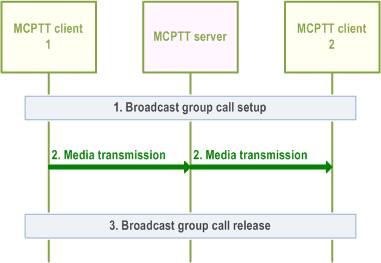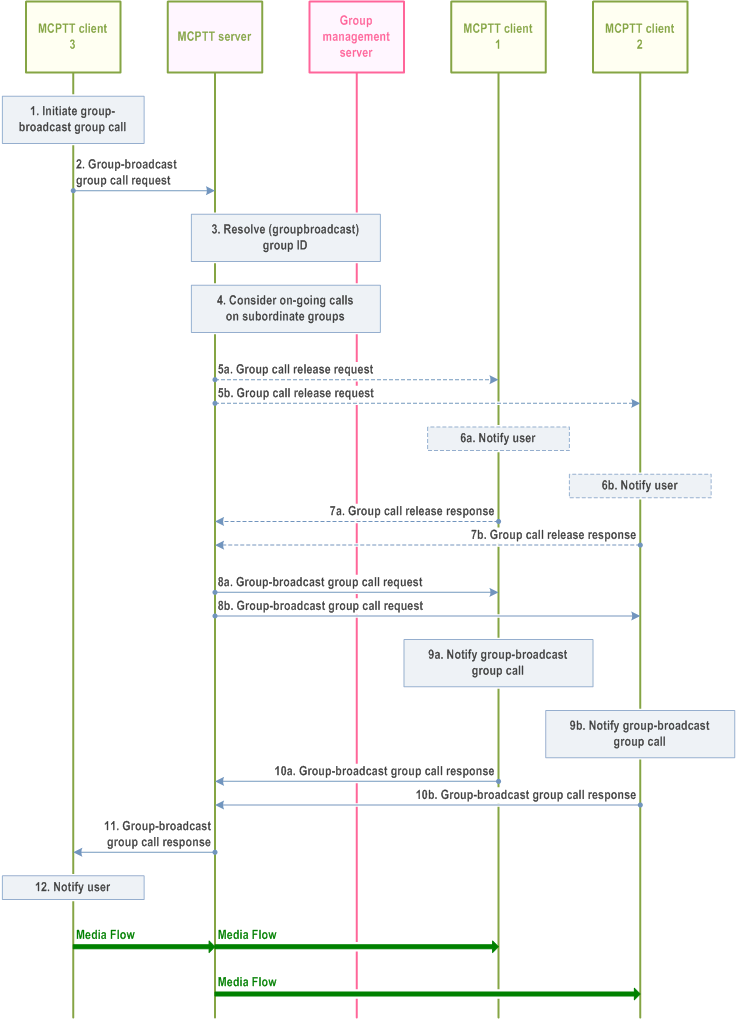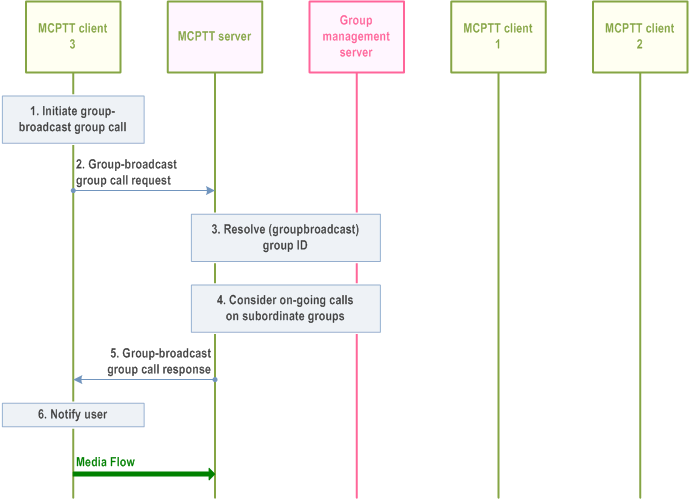Content for TS 23.379 Word version: 19.2.0
1…
7…
7.4…
10…
10.5…
10.6…
10.6.2.2.13…
10.6.2.2.24…
10.6.2.3…
10.6.2.3.1.2…
10.6.2.3.2…
10.6.2.4…
10.6.2.4.3…
10.6.2.5…
10.6.2.5.2.3…
10.6.2.6…
10.6.2.6.2…
10.6.2.7…
10.6.2.10…
10.6.3…
10.7…
10.7.2.2…
10.7.2.3…
10.7.3…
10.7.4…
10.7.5…
10.7.5.2.3a…
10.7.6…
10.7.6.2.3…
10.9…
10.9.1.3…
10.9.1.3.2…
10.9.1.3.3…
10.9.1.4…
10.9.1.5…
10.9.2…
10.9.2.6…
10.10…
10.12…
10.14…
10.15…
10.19…
10.19.2.11…
10.19.3…
10.19.3.1.4…
10.19.3.2…
10.19.3.2.4…
10.19.3.2.6…
A…
A.4…
B…
10.6.2.5 Broadcast group call
10.6.2.5.1 General
10.6.2.5.2 Common broadcast group call procedure
10.6.2.5.2.1 Group-broadcast group call procedure
10.6.2.5.2.2 Group-broadcast group call procedure when a subordinate group has an on-going MCPTT emergency group call
...
...
10.6.2.5 Broadcast group call p. 73
10.6.2.5.1 General p. 73
A broadcast group call is a special group call where the initiating MCPTT user expects no response from the other MCPTT users, so that when his transmission is complete, so is the call.
10.6.2.5.2 Common broadcast group call procedure p. 74
The group-broadcast group and the broadcast regrouped group are similar in structure (a collection of groups). Similarly the user-broadcast group and the pre-arranged group (a collection of users) are similar in structure. Only the call originator can transmit media during the broadcast group call and the broadcast group call is released when the transmission is complete, unless the call originator is overridden.
Figure 10.6.2.5.2-1 illustrates the common procedure for broadcast group call on group-broadcast group, user-broadcast group and broadcast regrouped group and pre-arranged groups.
Pre-conditions:
- MCPTT client 1 and MCPTT client 2 are members of a pre-arranged broadcast group/user-broadcast group/broadcast regroup group.
- Optionally, MCPTT client 1 may have an activated functional alias for the group communication.
- The MCPTT server may have subscribed to the MCPTT functional alias controlling server within the MC system for functional alias activation/ de-activation updates.

Step 1.
MCPTT user at MCPTT client 1 initiates the broadcast group call setup procedure with the indication of broadcast group call. The signalling procedure is identical to the group call setup as described in subclause 10.6.2.3 with the inclusion of the parameter for broadcast group call indicator. The MCPTT user at MCPTT client 1 may include a functional alias used for the broadcast group call and the MCPTT server checks whether the provided functional alias can be used and has been activated for the MCPTT user.
Step 2.
MCPTT client 1 starts to transmit media.
Step 3.
If the media transmission from call originating MCPTT user is complete, the broadcast group call is released.
10.6.2.5.2.1 Group-broadcast group call procedure p. 75
The group-broadcast group is defined as a set of groups, not a set of MCPTT users. The group-broadcast group is also defined with a hierarchy. It is expected that the MCPTT user that originates the group-broadcast group call is the only one transmitting media during the group-broadcast group call and that the group-broadcast group call is terminated when the transmission is complete. However, if the override feature is enabled, then the call originator may be overridden.
Figure 10.6.2.5.2.1-1 illustrates the procedure for group-broadcast group call establishment.
Pre-conditions:
- The group (e.g. A) to which MCPTT client 1 and MCPTT client 2 are members is a subordinate group of the group-broadcast group (i.e., the group-broadcast group was defined with group A as a subordinate group).
- The group (e.g. A) currently has an on-going MCPTT group call that is not an MCPTT emergency group call.
- The call initiator of the group-broadcast group is a member of another group (e.g., X, not group A) which is also a subordinate group of the group-broadcast group (i.e., the group-broadcast group was defined with group X as a subordinate group).
- The group-broadcast group and its subordinated groups are defined in the same group management server and served by the same MCPTT server.
- Optionally, MCPTT client 3 may have an activated functional alias for the group communication.
- The MCPTT server may have subscribed to the MCPTT functional alias controlling server within the MC system for functional alias activation/de-activation updates.

Step 1.
Resources are now available for the transmission from MCPTT client 3 to MCPTT client 1 and MCPTT client 2. Once the user of MCPTT cleint 3 completes transmitting, the group-broadcast group call is releases as are the resources.
MCPTT user at MCPTT client 3 initiates the group-broadcast group call setup procedure.
Step 2.
The MCPTT client 3 sends a group-broadcast group call request to the MCPTT server. The MCPTT user at MCPTT client 1 may include a functional alias used for the broadcast group call.
Step 3.
The MCPTT server checks whether the provided functional alias can be used and has been activated for the MCPTT user. The MCPTT server needs to resolve the group-broadcast group ID into its subordinate groups in order to contact the affiliated MCPTT users of those subordinate groups.
Step 4.
The MCPTT server then needs to consider any on-going group calls on those subordinate groups because this may affect the behaviour for what happens next. In this case a group call exists on a subordinate group. Thus, the MCPTT users involved in the group call on this subordinate group.
Step 5.
Optionally the on-going group call on a subordinate group may be terminated in which case the MCPTT client 1 and MCPTT client 2 need to be sent a Group call release request.
Step 6.
The MCPTT client 1 and MCPTT client 2 then notify their users of the group call release request.
Step 7.
The MCPTT client 1 and MCPTT client 2 respond to the group call release request by sending a group call release response.
Step 8.
A group-broadcast group call request is sent to both the MCPTT client 1 and the MCPTT client 2. The request may contain the functional alias of the calling party.
Step 9.
MCPTT client 1 and MCPTT client 2 notify their users of the incoming group-broadcast group call. The functional alias of the calling party, if available, is presented to the users.
Step 10.
MCPTT client 1 and MCPTT client 2 respond to the group-broadcast group call request by sending a group-broadcast group call response.
Step 11.
The MCPTT server responds to MCPTT client 3 (the call initiator) that the group-broadcast group call has been established by sending a group-broadcast group call response.
Step 12.
The MCPTT client 3 notifies its user that the user can begin transmitting using the group-broadcast group call resources.
10.6.2.5.2.2 Group-broadcast group call procedure when a subordinate group has an on-going MCPTT emergency group call p. 77
The group-broadcast group is defined as a set of groups, not MCPTT users. The affiliated MCPTT group members of a subordinate group with an on-going MCPTT emergency group call are not interrupted by a group-broadcast group call.
Figure 10.6.2.5.2.2-1 illustrates the procedure for group-broadcast group call when a subordinate group has an on-going MCPTT emergency group call.
Pre-conditions:
- MCPTT The group (e.g. A) to which MCPTT client 1 and MCPTT client 2 are members is a subordinate group of the group-broadcast group (i.e., the group-broadcast group was defined with group A as a subordinate group).
- The group (e.g. A) currently has an on-going MCPTT emergency group call.
- The call initiator (user of MCPTT client 3) of the group-broadcast group is a member of another group (e.g., X, not group A) which is also a subordinate group of the group-broadcast group (i.e., the group-broadcast group was defined with group X as a subordinate group).

Step 1.
Resources are now available for the transmission from MCPTT client 3 to the MCPTT clients (not shown) of other subordinate groups (i.e., not A). Once the user of MCPTT cleint 3 completes transmitting, the group-broadcast group call is releases as are the resources.
The MCPTT user at MCPTT client 3 initiates the group-broadcast group call setup procedure.
Step 2.
The MCPTT client 3 sends a group-broadcast group call request to the MCPTT server.
Step 3.
The MCPTT server needs to resolve the group-broadcast group ID into its subordinate groups in order to contact the affiliated MCPTT group members of those subordinate groups.
Step 4.
The MCPTT server then considers any on-going group calls on those subordinate groups (e.g. A) because this may effect the behaviour for what happens next. In this case an emergency group call exists on a subordinate group.
Step 5.
The MCPTT server responds to the call initiator that the group-broadcast group call has been established.
Step 6.
The MCPTT client 3 notifies its user that the user can begin transmitting using the group-broadcast group call resources.